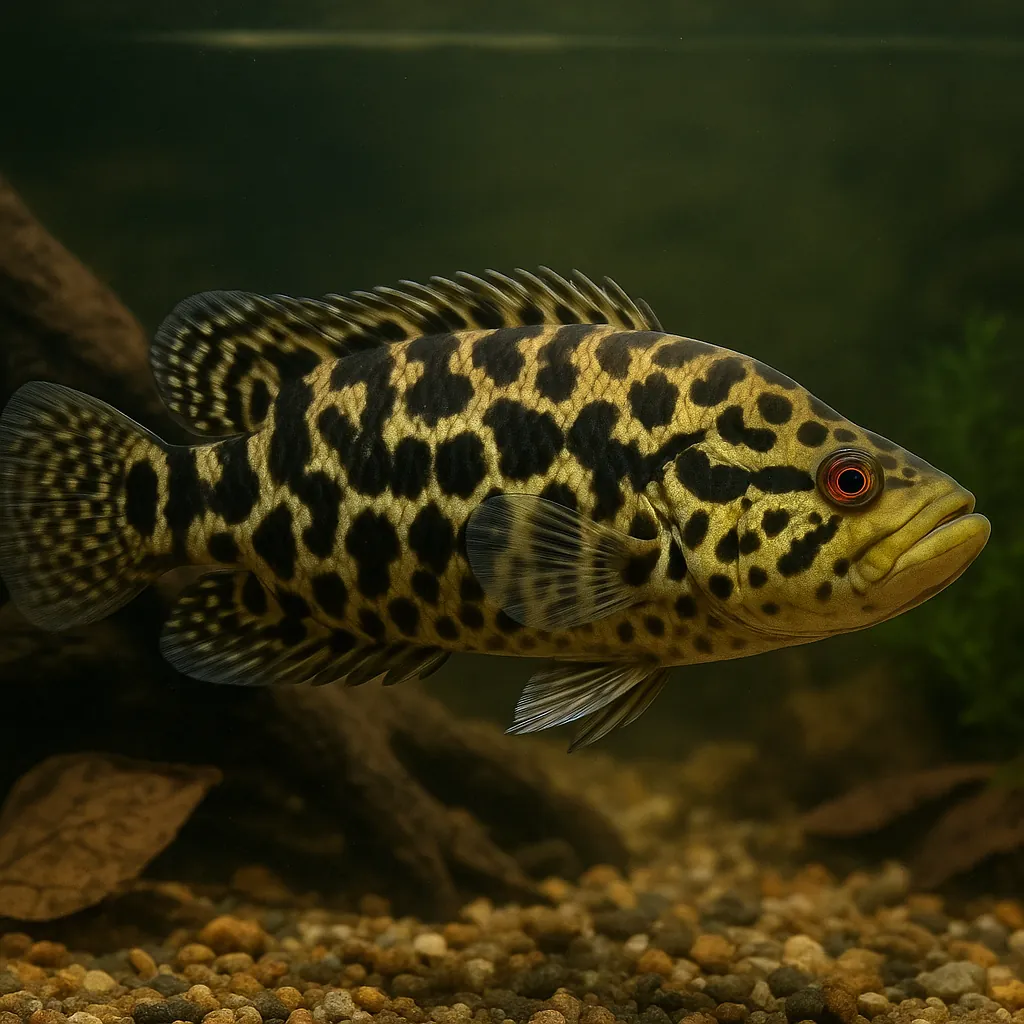
Jaguar cichlid
Introduction
The Jaguar cichlid (Parachromis managuensis), also known as the Managuense cichlid or Aztec cichlid, is a striking freshwater fish native to Central America. Renowned for its bold, jaguar-like patterning and dynamic personality, this species has captivated aquarists seeking a challenging yet rewarding addition to their tanks. However, due to its substantial size and aggressive nature, the Jaguar cichlid is best suited for experienced fishkeepers prepared to meet its specific care requirements.
What makes the Jaguar cichlid a popular choice among aquarists?
Its unique appearance, characterized by dark spots and a golden-bronze hue, combined with its interactive behavior, makes it a standout species for those interested in large, predatory fish.
Is the Jaguar cichlid suitable for beginners?
Due to its size, aggression, and specific care needs, it's generally recommended for intermediate to advanced aquarists.
Care and Environment
Proper care for the Jaguar cichlid involves attention to tank size, water parameters, diet, and habitat setup to ensure a healthy and thriving fish.
What is the minimum tank size for a Jaguar cichlid?
A single Jaguar cichlid requires a minimum tank size of 500 liters to accommodate its growth and territorial behavior. For a pair, a larger tank of at least 720 liters is recommended to provide sufficient space and reduce aggression.
What are the ideal water parameters for this species?
Maintain water temperatures between 25°C and 36°C, with a pH range of 7.0 to 8.7. Regular monitoring and maintenance are crucial to keep these parameters stable.
How should the tank be set up to mimic the Jaguar cichlid's natural habitat?
Use a substrate of soft sand or small rounded gravel, and incorporate significant pieces of driftwood and rocks to create secure, sheltered areas. Ensure these elements are firmly anchored, as Jaguar cichlids may rearrange decor. Sturdy aquatic plants like Anubias species and Java Fern can be added for shaded hiding spots.
What is the recommended diet for Jaguar cichlids?
In the wild, they are skilled predators feeding on fish and large invertebrates. In captivity, provide a varied diet including high-quality carnivorous pellets, live or frozen foods such as bloodworms, mealworms, and small fish.
Are there specific challenges in keeping Jaguar cichlids?
Yes, their aggressive and territorial nature can pose challenges, especially during breeding. They require ample space and careful selection of tank mates to prevent conflicts. Additionally, their large size demands robust filtration systems to maintain water quality.
Origin and Habitat
The Jaguar cichlid is indigenous to the Atlantic slope of Central America, ranging from the Ulúa River in Honduras to the Matina River basin in Costa Rica.
What types of environments do Jaguar cichlids inhabit in the wild?
They are found in various freshwater bodies, including lakes, ponds, and rivers, often preferring turbid, slow-moving waters with muddy or sandy substrates.
How do seasonal variations affect their natural habitat?
While specific seasonal variations are not well-documented, Jaguar cichlids are known to adapt to a range of conditions, including hypoxic (low oxygen) environments, indicating a high level of resilience.
Temperament and Compatibility
Jaguar cichlids are known for their aggressive and territorial behavior, making them challenging to house with other fish.
Can Jaguar cichlids be kept with other fish?
Due to their aggression, they are best kept alone or with other large, similarly aggressive cichlids in a spacious tank. Suitable tank mates include species like Oscar fish, Green Terror cichlids, and Red Devil cichlids.
How do they behave during breeding?
During breeding, their aggression intensifies. Both parents are highly protective of their offspring, often becoming more territorial and potentially attacking other tank inhabitants.
What strategies can help manage their aggression?
Providing a large tank with plenty of hiding spots and visual barriers can help reduce aggression. Ensuring each fish has its own territory and monitoring interactions closely is essential.
Interesting Facts
Beyond their striking appearance and challenging care requirements, Jaguar cichlids possess several fascinating traits.
How did the Jaguar cichlid get its name?
The species is named for its distinctive patterning, which resembles the spots of a jaguar, giving it a unique and appealing look.
Do Jaguar cichlids exhibit any notable behaviors?
They are known for their intelligence and can recognize their owners. Additionally, they may rearrange tank decor to suit their preferences, showcasing their interactive nature.
What is their lifespan in captivity?
With proper care, Jaguar cichlids can live up to 15 years, making them a long-term commitment for aquarists.
Sources
All information in this article has been gathered from the following reputable sources:
Overview
Recommended Tank Size 190.2 Gallons (for a pair) |
Minimum Group Size 1 |
Minimum Tank Volume 132.1 Gallons |
Maximum Adult Length 25.6 inches |
Average Adult Length 15.7 inches |
Shoaling (6+ required) No |
Preferred Water Type Freshwater, pH 7.0–8.7, temperature 25–36°C |
Temperature Range (°C) 25–36 |
pH Range 7.0–8.7 |
Water Hardness (dGH) 10–15 |
Typical Lifespan (years) 15 years |